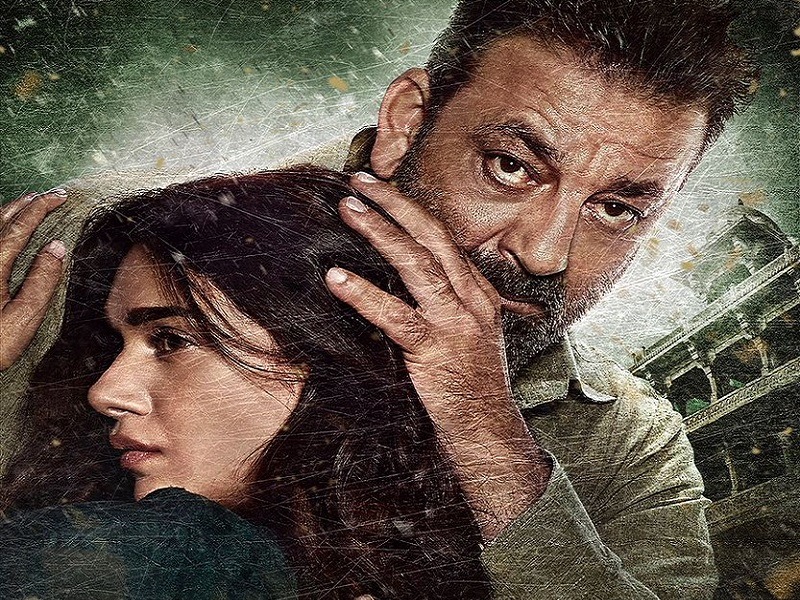On one level, it’s no big deal that Bhoomi is a second-rate film. As it is, we make enough bad films here. It’s bigger crime, however, is the sheer insensitive and irresponsible manner in which it handles a serious and delicate subject like rape.
There’s practically nothing that Bhoomi has going for it as it takes you back to the worst of the 1980s when vigilante films like Insaaf Ka Tarazu (1980) and Zakhmi Aurat (1988) hid behind the guise of being films on ‘women’s issues.’ These exploitative films caused far more harm to the very social themes they seemed to address rather than help them. One knows just how tough it is for a woman in India who is raped to get justice right from filing the FIR, to being mentally raped in court, to the ridiculously low percentage of actual convictions, and finally, to being just allowed to live her life. Bhoomi treats these scenes so shoddily, typically and superficially that it makes you gag. And merely making reference to current affairs in the country (one of the men involved is a minor) doesn’t give the film any extra depth or any sort of perceptive outlook on director Omung Kumar’s part.
The film is sloppily written. The self-conscious ‘filmi-cute’ scenes between shoemaker father, Sanjay Dutt, and his wedding planner daughter, Aditi Rao Hydari, or the unfunny drunken ones between Dutt and his tourist guide buddy, Shekhar Sumar, don’t help in creating the necessary empathy for the good guys while the baddies are your usual cardboard caricatures. The mediocrity, lack of subtlety, and the worst tropes of mainstream Indian cinema come through rather strongly as for instance, the camera revels on Sunny Leone’s mud-covered body in the crassly designed item number in a film that is supposed to be sensitive to women and their bodies. Even the bit where where the various women take a stand against their menfolk seems tokenism at best in a narrative that drags on and on, making you highly aware of each of its 130-odd minutes running time before ending with a climax that is bizarre to say the least.
The performances too can’t save the film. Aditi Rao Hyadari, playing the title role, is sincere but insipidly weak, often defeated by the script. It’s painfully apparent that it’s beyond the capability of the film to credibly handle her psyche and mental make up post the rape. Sanjay Dutt, admittedly, has his odd moments as the anguished father turned avenging angel but that’s really it, definitely needing a better film for his big ‘comeback’. Incidentally, what is with playing vigilantes in these revenge dramas where they bring their children’s rapists to book that attracts older stars returning to the silver screen? We had Raveena Tandon in Maatr, Sridevi in Mom and now Dutt here.
There’s little to talk about the technicalities. The biggest liabilities are Ismail Darbar’s loud, unrelenting background score and the on-location filming. Bhoomi fails to capture the spirit or essence of Agra, where it is set, merely reinforcing the stereotype that Agra is little more than the Taj, shoes and its translucent sweet, the petha.
All in all, highly avoidable.
Hindi, Action, Drama, Color



I am not going to outright condemn this film since I have not seen it yet, but when the writer drew a connection between Bhoomi and older films on a similar trope, particularly Insaaf Ka Tarazu, I was reminded of an old article by Urvashi Butalia on the depiction of women in Indian cinema, which I read several years back.
In the article, Butalia lamented on the fact that when Insaaf Ka Tarazu ran in theatres, many male moviegoers were glued to the screens during Padmini Kolhapure’s rape scene not because their hearts were reaching out in sympathy for the plight of the character she was playing, but rather because they were aroused by the dramatisation of a woman being physically violated before their eyes.
Understandably, the prevalent patriarchal overtones in India’s cultural norms that have long undermined her womenfolk may take the bulk of the blame for such an appalling reaction to a film (or at least one of its scenes) ostensibly made to raise awareness on women’s rights, but in my opinion the responsibility still lies by and large on the shoulders of the storytellers themselves, ie the filmmakers.
While the credibility of Butalia’s observation may raise a question or two among those who have not read her aforesaid article yet, one truth remains clear, at least for me, though: unless filmmakers start to take women’s issues seriously by revolving profoundly humane storylines around them, instead of exploiting them as mere pretexts for vengeance and retribution, cinema will ultimately fail to educate the general public on the pressing need to stand up with – and not shun and vilify – the scores of women who have been victimised under such cruel and grievous circumstances.
Just my two cents’ worth…